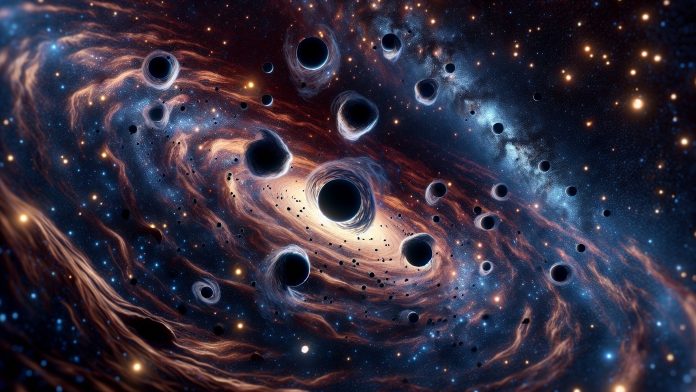Dark matter, which makes up about 80% of the Universe’s matter, has puzzled scientists for decades. Despite extensive research, its true nature remains elusive.
The leading hypothesis has been that dark matter consists of exotic, invisible particles that exert gravitational forces, but attempts to detect these particles directly have yet to succeed. In a new study, a team of MIT physicists proposes an alternative theory: dark matter might be made up of primordial black holes.
These microscopic black holes, formed in the chaotic moments after the Big Bang, could explain the gravitational effects attributed to dark matter.
If correct, these black holes might even be detected through their interactions with our solar system, specifically by causing slight shifts in Mars’ orbit.
What are primordial black holes?
Primordial black holes were first theorised in the 1970s, but the idea has gained renewed interest in recent years as particle-based theories of dark matter have yet to yield results.
Unlike black holes formed from collapsing stars, primordial black holes would have originated from dense regions of gas in the early Universe, immediately after the Big Bang. These objects, despite being microscopic in size—some as small as an atom—would carry enormous amounts of mass.
If these black holes do exist, they would have scattered across the Universe as it expanded and cooled. Although their mass would be small on a cosmic scale, their gravitational pull could be strong enough to explain the effects attributed to dark matter.
Led by Professor David Kaiser, the MIT team suggests that primordial black holes, despite their tiny size, could carry immense mass comparable to that of an asteroid.
They theorise that these black holes could occasionally pass through our solar system and, in doing so, subtly influence the orbits of planets.
Kaiser and his colleagues estimate that such a black hole could pass near Mars roughly once every decade.
If this occurs, it could cause a slight ‘wobble’ in Mars’ orbit—a deviation that today’s high-precision instruments, which track the distance between Earth and Mars to within 10 centimetres, might be able to detect.
The effect of a black hole flyby
Initially, the team wondered how a primordial black hole might affect a human. Tung Tran, lead author of the study, calculated that if one passed within a meter of a person, it could exert a force strong enough to move them several meters in a second—although the odds of such a close encounter are astronomically low.
The researchers then shifted their focus to larger objects, such as the Earth and Moon. However, their simulations showed that the complex gravitational dynamics of the Earth-moon system made it difficult to pin down the effects of a black hole flyby. Mars, however, offered a clearer picture.
By simulating the flyby of an asteroid-mass black hole near Mars, the researchers found that such an encounter could cause a small deviation in the planet’s orbit—a wobble of about a metre, measurable over the course of several years.
Simulating the solar system
To better understand this potential effect, the MIT team developed simulations of the solar system, including the planets, moons, and other large objects.
While typical solar system simulations can include millions of objects, the researchers simplified the model to focus on the key gravitational interactions.
Their calculations also factored in the distribution and velocity of dark matter in the galaxy, assuming that any passing primordial black holes would travel at around 150 miles per second.
The team then simulated various flyby scenarios, looking for instances where a black hole’s gravitational pull could cause a measurable wobble in Mars’ orbit.
Of course, detecting such a wobble is only the first step. Any gravitational influence could also be caused by a large asteroid or other space debris.
To differentiate between a black hole and a mundane space rock, the team is working on refining their simulations to compare the paths and speeds of regular space objects with those of primordial black holes.
If a wobble in Mars’ orbit were detected in the coming years, it could provide a major clue in the search for dark matter.
However, confirming that the effect was caused by a primordial black hole rather than an asteroid would require further investigation, including long-term monitoring and additional simulations.
The team is also exploring partnerships with other researchers to simulate even more detailed scenarios involving a larger number of objects in the solar system.
A new path forward for dark matter research
The potential discovery of primordial black holes would mark a major breakthrough in the search for dark matter.
By offering a plausible explanation for the gravitational effects seen in galaxies and other cosmic structures, these tiny black holes could solve one of physics’ biggest puzzles.
As technology continues to advance and simulations grow more sophisticated, the likelihood of detecting such a black hole increases.
If a subtle wobble in Mars’ orbit is confirmed to be the result of a primordial black hole, it could reshape our understanding of dark matter and open new avenues for exploring the early Universe.









